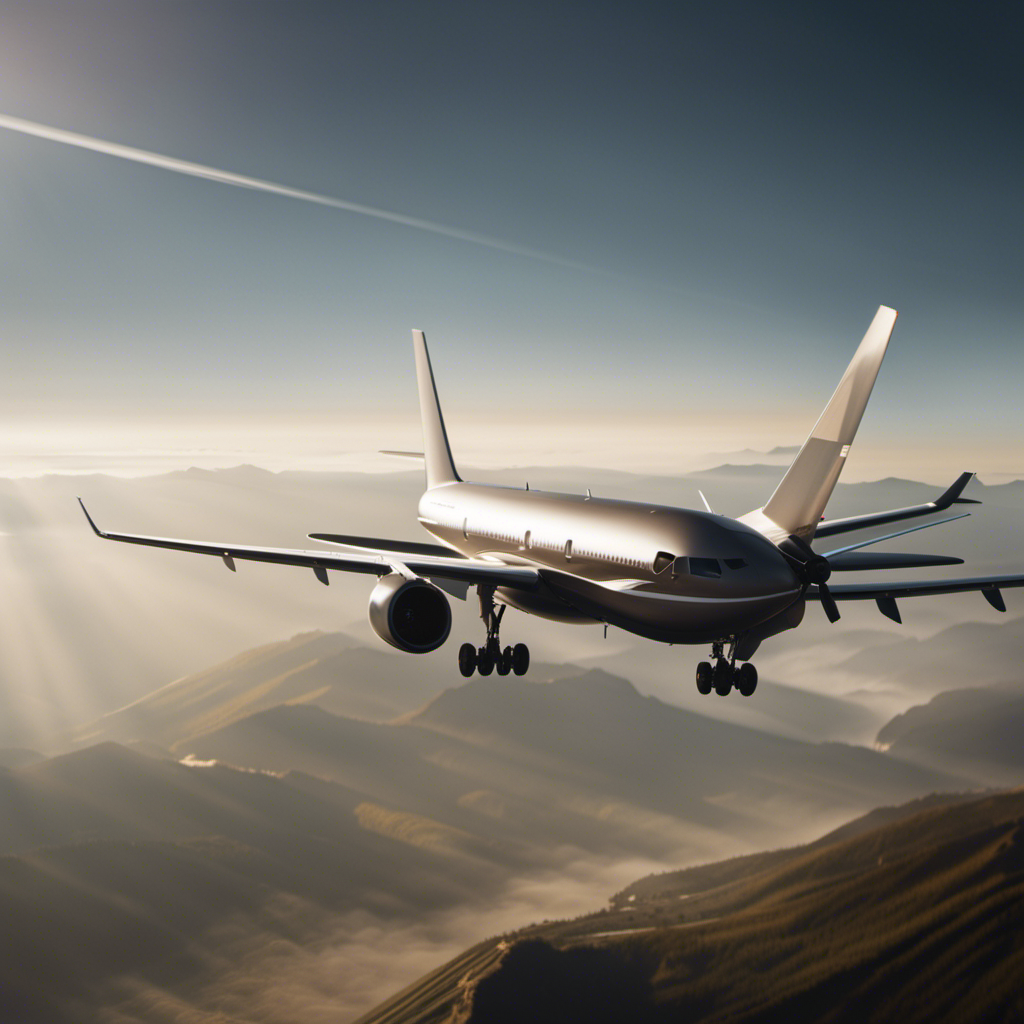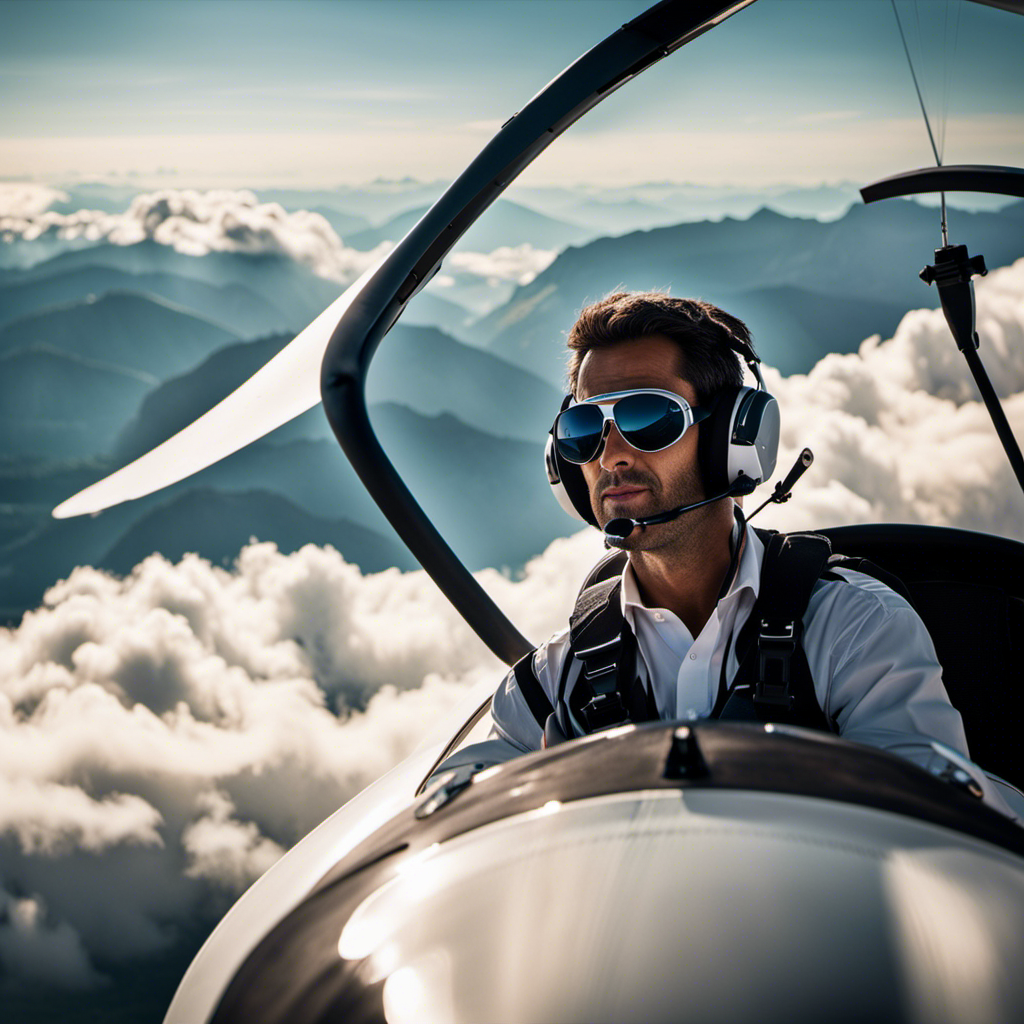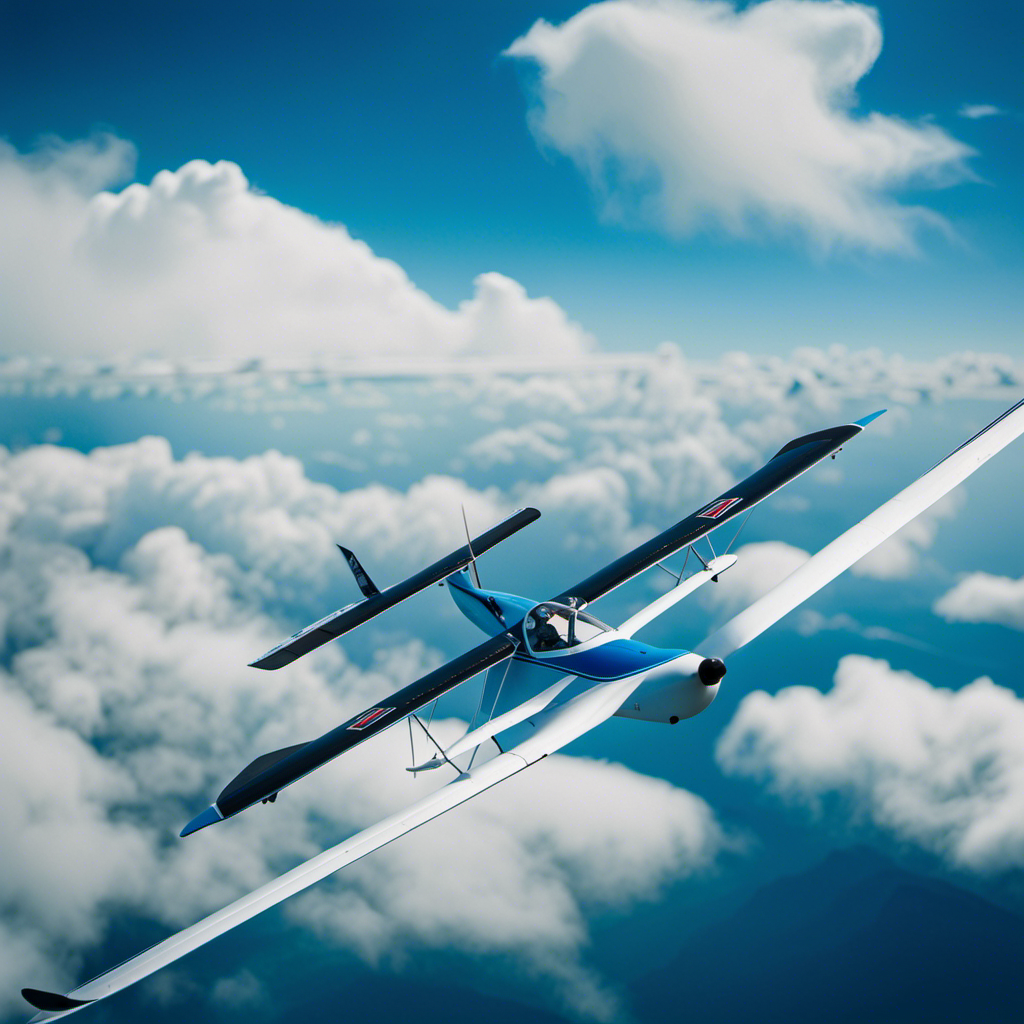Did you know that airplanes don’t just fall out of the sky when they lose power? In fact, aircrafts have the ability to glide thanks to the fascinating principles of aerodynamics.
In this article, I will explore the science behind why planes glide instead of plummeting to the ground. By understanding the role of lift and drag, the importance of wings, and the function of the airfoil shape, we can unravel the mystery of how pilots control a gliding plane.
Get ready to delve into the world of aviation and discover the engineering marvel that keeps planes soaring even when the engines fail.
Key Takeaways
- Maintaining control and finding suitable landing spots are crucial during engine failure.
- Modern aircraft are designed with redundant systems and backup procedures to ensure safe landing during engine failure.
- Glide performance is influenced by factors such as altitude, airspeed, and the pilot’s decision-making.
- Successful glides have debunked myths about planes falling from the sky, with examples like the ‘Miracle on the Hudson’ showcasing skilled pilots saving lives through safe gliding.
The Mechanics of Flight
Planes can either fall or glide depending on the mechanics of flight. Understanding the principles of aerodynamics and the forces in flight is crucial to comprehend how planes stay airborne.
In order for a plane to stay in the air, it must overcome the force of gravity with an opposing force called lift. Lift is generated by the wings of the plane, which are designed with a curved shape called an airfoil. As the plane moves forward, air flows over the wings, creating a pressure difference that generates lift.
However, lift is not the only force at play. Drag is another force that acts opposite to the direction of motion, slowing the plane down. By balancing lift and drag, planes can maintain a steady glide or controlled descent.
Understanding the role of lift and drag is essential in comprehending the mechanics of flight.
Understanding the Role of Lift and Drag
Understanding the role of lift and drag is crucial in comprehending how aircraft stay airborne. Lift is the force that opposes the weight of the aircraft, allowing it to overcome gravity and stay in the air.
Drag, on the other hand, is the resistance that the air exerts on the aircraft as it moves through it.
To fully grasp the importance of lift and drag, consider the following:
-
Lift is generated by the shape of the wings, with the curved upper surface creating lower pressure and the flatter lower surface creating higher pressure.
-
Drag is affected by factors such as the shape of the aircraft, its speed, and the surface roughness.
-
To optimize flight efficiency, aircraft designers strive to minimize drag while maximizing lift.
Understanding the role of lift and drag sets the stage for comprehending the importance of wings in gliding, as they play a vital role in generating lift and managing drag.
The Importance of Wings in Gliding
To truly appreciate the significance of wings in gliding, you’ll want to consider how they work to generate lift and manage drag. The aerodynamics of wings play a crucial role in allowing an aircraft to glide effectively.
Lift is created by the shape of the wing, which is designed to generate a pressure difference between the upper and lower surfaces. This pressure difference results in an upward force that counteracts the influence of weight, allowing the aircraft to stay aloft. The weight of the aircraft, along with other factors such as airspeed and angle of attack, can affect the gliding performance.
By understanding the aerodynamics of wings and how weight influences gliding, pilots can optimize their flight strategies and make the most of their aircraft’s capabilities.
Transitioning into the subsequent section about the function of the airfoil shape, it is important to delve into the specific design elements that contribute to efficient gliding.
The Function of the Airfoil Shape
The function of the airfoil shape is crucial in determining the efficiency of gliding. An airfoil is a specific shape given to the wings of an aircraft to generate lift. Here are three key aspects of airfoil design and aerodynamic principles that contribute to successful gliding:
- Camber: The curvature of the airfoil’s upper surface creates a pressure difference, generating lift.
- Angle of Attack: The angle at which the airfoil meets the oncoming airflow affects lift and drag forces.
- Boundary Layer Control: Smooth airflow over the airfoil’s surface is essential for optimal performance. Techniques like winglets and vortex generators help control the boundary layer.
Understanding these elements allows engineers to design airfoils that maximize lift and minimize drag, enabling planes to glide efficiently.
Transitioning to how pilots control a gliding plane, they employ various techniques to maintain stability and control, which we will explore in the next section.
How Pilots Control a Gliding Plane
Pilots use various techniques to maintain stability and control while gliding. These techniques are a crucial part of pilots’ training and are essential for emergency situations.
One of the primary techniques is adjusting the elevator control to control the pitch of the aircraft. By adjusting the elevator, pilots can control the nose-up and nose-down movements, ensuring the glider maintains a stable and controlled flight path.
Another technique is using ailerons to control the roll of the aircraft. By moving the ailerons, pilots can bank the glider and control its turning movements.
Rudder control is also vital for maintaining stability during gliding. Pilots use the rudder to control the yaw, ensuring the aircraft stays on the intended flight path.
These techniques, along with emergency landing techniques, are critical for pilots to safely land a gliding aircraft in emergency situations, such as engine failure.
Emergency Procedures for Engine Failure
When your engine fails during a flight, remember to remain calm and follow the emergency procedures.
In the event of an engine failure, the pilot’s immediate priority is to find a suitable location for an emergency landing. This requires careful assessment of the terrain and available landing options.
The pilot will then initiate the emergency descent procedure, lowering the aircraft’s nose to maintain airspeed and control.
The next step is to communicate the emergency situation to air traffic control and declare an emergency. This ensures that other aircraft in the vicinity are aware of the situation and can provide assistance if needed.
Throughout the emergency landing, aircraft safety is of utmost importance, with the pilot implementing all necessary measures to protect the passengers and crew.
Transitioning to the subsequent section about real-life examples of successful glides, it is evident that following proper emergency procedures can lead to positive outcomes in dire situations.
Real-Life Examples of Successful Glides
In real-life emergency situations, you can witness the remarkable skill and quick thinking required to execute successful glides. Pilots rely on their training and experience to safely land a plane when the engine fails. Here are some examples of successful glides:
| Example | Aircraft Type | Outcome |
|---|---|---|
| 1 | Cessna 172 | Landed on a highway, no injuries |
| 2 | Airbus A320 | Landed in a river, all passengers survived |
| 3 | Boeing 777 | Landed on a grass field, minimal damage |
| 4 | Piper Cherokee | Landed in a field, no injuries |
| 5 | Embraer E190 | Landed on a beach, no casualties |
These examples highlight the importance of maintaining control and finding suitable landing spots during an engine failure. Factors such as altitude, airspeed, and the pilot’s decision-making play a crucial role in achieving a successful glide. Transitioning into the next section, let’s explore the factors that affect a plane’s glide ratio without writing ‘step’.
Factors that Affect a Plane’s Glide Ratio
Factors such as altitude, airspeed, and the pilot’s decision-making significantly impact a plane’s glide ratio. Glide performance is a measure of how efficiently an aircraft can maintain forward motion without power. It is influenced by the balance between the aerodynamic forces acting on the plane.
Altitude plays a crucial role in determining how far a plane can glide. The higher the altitude, the greater the potential energy available for the aircraft to convert into forward motion.
Additionally, airspeed affects the glide ratio by influencing the amount of lift generated by the wings.
Finally, the pilot’s decision-making skills, including their ability to select an appropriate landing site and manage the aircraft’s energy, also contribute to the overall glide performance.
Understanding these factors is essential to debunking myths about planes falling from the sky, as it highlights the critical role of gliding in emergency situations.
Debunking Myths about Planes Falling from the Sky
Understanding the critical role of gliding in emergency situations is essential for debunking myths about planes falling from the sky. Contrary to popular belief, planes are not destined to crash when their engines fail. In fact, historical examples abound where skilled pilots have managed to safely glide their aircraft to the ground, saving countless lives.
One such example is the famous ‘Miracle on the Hudson’ in 2009, when Captain Chesley Sullenberger successfully landed US Airways Flight 1549 on the Hudson River after both engines failed. This remarkable feat demonstrated the effectiveness of gliding as a means of emergency landing.
These historical examples not only debunk misconceptions about planes falling from the sky, but also highlight the importance of pilot training and the engineering marvel of modern aircraft, which I will discuss in the next section.
The Engineering Marvel of Modern Aircraft
The engineering marvel of modern aircraft is evident in their ability to safely land even when faced with engine failure. Thanks to advancements in aviation technology and modern aircraft design, planes are equipped with redundant systems and backup procedures to ensure the safety of passengers and crew.
In the event of an engine failure, pilots rely on a combination of glide ratio and glide speed to maintain control and safely bring the aircraft to the ground. Modern aircraft are designed with optimal aerodynamics, which allow them to glide efficiently and maintain stability during emergency situations.
Additionally, cockpit instruments and flight control systems provide pilots with real-time information and assist in making critical decisions. These advancements in technology have greatly enhanced the safety and reliability of air travel, making modern aircraft a true engineering marvel.
Frequently Asked Questions
What are some common emergency procedures that pilots follow in the event of engine failure during flight?
In the event of engine failure during flight, pilots follow common emergency procedures. These procedures include identifying the failed engine, securing it, and initiating a controlled descent or landing depending on the altitude and available options.
Can a plane glide without any power from the engines?
In emergency situations, planes can glide without power from the engines. Pilots follow specific emergency procedures to maintain control and maximize the glide ratio, allowing the aircraft to safely descend and potentially reach a designated landing area.
What are some factors that can affect a plane’s glide ratio?
Factors that can affect a plane’s glide ratio include its weight, wing design, altitude, and airspeed. These factors impact the plane’s performance in terms of maintaining lift and minimizing drag, ultimately determining how efficiently it can glide without power.
Is it true that planes can "fall" out of the sky?
Yes, it is true that planes can fall out of the sky. This is a critical concern in aviation safety. Understanding the factors that can cause a plane to fall is crucial for maintaining safe flight operations.
Can you provide any real-life examples of successful glides where pilots were able to safely land a plane without engine power?
Real-life examples of successful glides without engine power include the "Miracle on the Hudson" when Captain Sully Sullenberger safely landed a plane on the Hudson River. Such successful glides highlight the importance of pilot training.
Conclusion
In conclusion, after delving into the mechanics of flight and understanding the role of lift and drag, it becomes clear that planes do not simply fall from the sky. Instead, they glide gracefully through the air, guided by skilled pilots who manipulate the airfoil shape and control the plane’s movements.
Just like a bird soaring effortlessly through the clouds, planes navigate the skies with precision and grace, showcasing the engineering marvel of modern aircraft.
Orion, better known as “Jetstream,” is the voice that brings the stories of the skies to life. His fascination with aviation began at a young age, sparked by his father’s tales of flying and adventure. Orion’s journey into the world of gliding was serendipitous, and from the moment he took his first glider flight, he knew he had found his calling.










